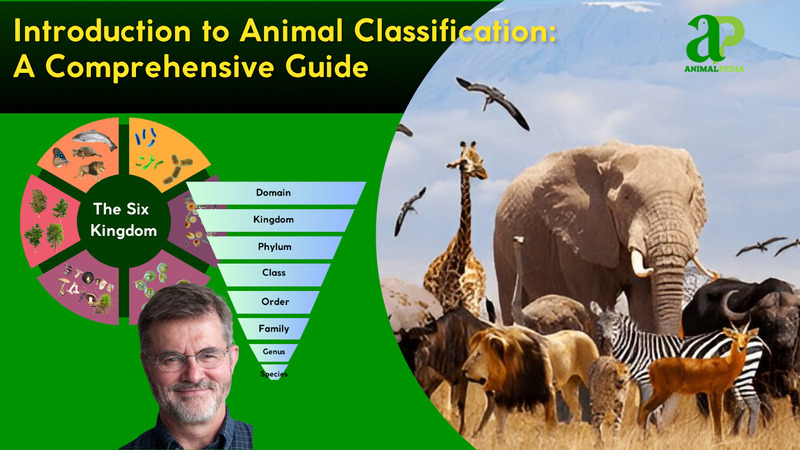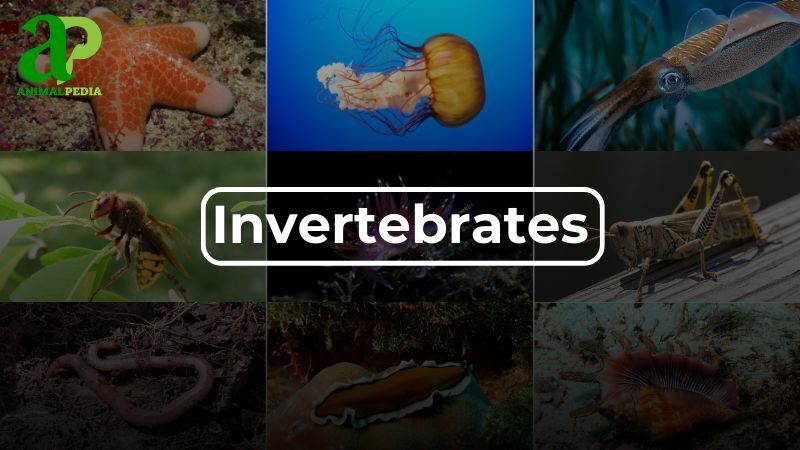Why is Animal Classification Important?
There are four reasons that make animal classification important as follows.
Understanding Biodiversity
There are hundreds of thousands of different species of creatures waiting for you to discover if you are passionate about biology. Knowing where to begin will be challenging, however. Animal classification provides a systematic way to understand the biological world.
Identify Patterns
Animal traits that are inherited biologically are easier to identify when they are grouped. As a result, scientists will be able to discover which species are related to each other, making evolution easier to study.
Conservation
Thanks to the groups, animal conservation is effectively promoted withthanks to the element of localized scope. Classification is a way to better understand ecosystems and know which animal groups need to be conserved to provide a balanced ecosystem.
Practical Applications
In addition, having specific groups also plays an important role in tracing and controlling epidemics. For example, human Metapneumovirus is very close to Metapneumovirus C (AMPV-C) found only in birds, from which people can clearly localize the source of infection of this virus to birds. When a new species is discovered, very quickly, it is placed in the same group as its relatives, which makes naming or studying this species much simpler.
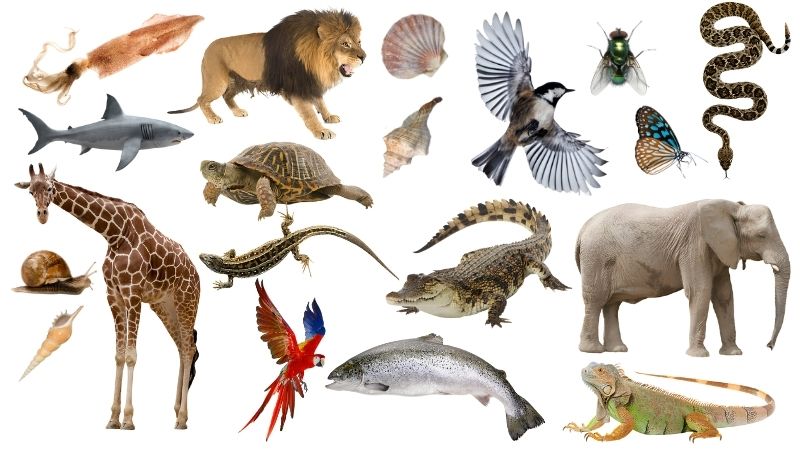
Basics of Animal Classification
Animal classification systematically organizes Earth’s vast biodiversity by grouping species according to shared traits and evolutionary connections.
Understanding Taxonomy
Taxonomy involves the study of the relationships between living things and their grouping into groups according to hypothesized relationships. Species are categorized according to their similarities and differences.
Hierarchical System
Taxonomy is organized in 8 levels:
- Domain: Bacteria, Archaea, and Eukarya make up the three domains of life on earth. Bacteria and Archaea, among others, are single-celled microorganisms without DNA in their nucleus. Eukarya contains all organisms that have DNA in the cell nucleus.
- Kingdom: There are four Kingdoms in the Eukarya group, namely Protista, Fungi, Plantae, and Animalia. Animalia consists of all animals.
- Phylum: There are about 31 phyla in the Animalia Kingdom that cannot be listed all here. Most animals, however, belong to one of the following Phyla: Arthropoda (millipedes, spiders and crayfish), Cnidaria (corals, jellyfish, hydras), Chordata (people and dogs), Mollusca (slugs, snails and chitons), Nematoda (threadworms, hookworms and whipworms), and Porifera (sponges and other invertebrate animals).
- Class: There are 108 classes in different Phyla and Subphyla. Chordata, for example, includes classes Amphibia (amphibians), Sauropsida (reptiles, dinosaurs, birds), Aves (birds), and Mammalia (mammals).
- Order: Breaking down the Reptiles class reveals 4 familiar orders, including: Testudines (turtles); Crocodilia (crocodiles); Squamata (lizards and snakes); and Rhynchocephalia (tuatara).
- Family: Orders can be further divided into Families. As an example, the family Squamata includes the families Varanidae (monitor lizards, Komodo dragons) and Anguidae (snake lizards, glass lizards, etc.)
- Genus: Families are further divided into Genera. Familie Anguidae includes Genera Anguis (snake lizards), Ophisaurus (glass lizards), Pseudopus (European legless lizards), etc.
- Species: Each genus has its own species. For instance, six species of Anguis (Snake Lizards) still exist on earth, primarily Anguis Fragilis.
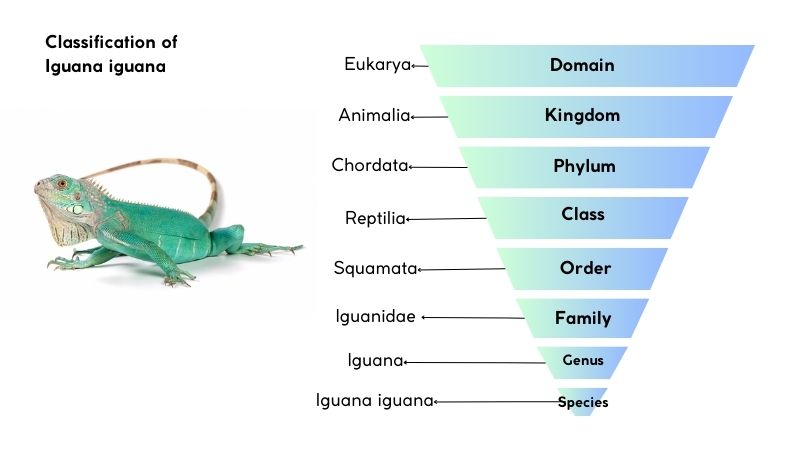
This example of the lizard (Iguana iguana) will clarify how animals are classified:
| Taxon | Classification |
| Domain | Eukarya |
| Kingdom | Animalia |
| Phylum | Chordata |
| Class | Reptilia |
| Order | Squamata |
| Family | Iguanidae |
| Genus | Iguana |
| Species | Iguana iguana |
Role of DNA & Genetics
Biology has entered a new era with DNA and genetics. By bringing new discoveries as well as changing the correctness of old theories, genetic research has given humanity a wealth of surprises.
- Beyond appearance: Animal classification has historically been based almost entirely on physical characteristics. In the field of DNA & Genetics, scientists are able to conduct more reliable research on species relationships with the help of technology.
- Reshaping our understanding: Previously, scientists have proposed many classification systems based on subjective observations, so these systems can be inaccurate when it comes to genetics. Genetics & DNA offer more accurate results because they are based on genetic evidence and can correct what previously was considered correct.
The History of Animal Classification
It’s not just recently, humans have been thinking about grouping animals for a long time. Grouping is not just done in a day or two but takes a lot of time and is gradually perfected through many different versions. Let’s go through history to name the versions of animal classification systems.
Aristotle’s Early System
Aristotle constructed his Early System through physical observations based on a basic understanding of species’ characteristics. Using habitat as a criterion for classification, he divided animals into groups. As a result, there are three types of animals: those living on land, in water, and in the air.
Linnaeus and Binomial Nomenclature
Developed by Carolus Linnaeus, the father of taxonomy, this system is still in use today. In his work, he created a system of identifying animals and plants throughout the world in a uniform manner. Linnaeus’ binomial system identifies each species by a generic name (genus) and a specific name (species). Applied to animals in 1758, this system continues to be used today.
The Tree of Life
The Tree of Life represents the relationships between animals of different species. Modern biologists have developed more complex versions of the Tree of Life since Edward Hitchcock’s simple 1840 version.
Genetic Revolution
As a result of modern biology, it is now possible to compare the genomes of different animal species to determine their relationships. There are surprising connections between seemingly unrelated species based on genetic comparisons. For example, according to the evolutionary tree of life, tuataras are reptiles endemic to New Zealand like most lizards. Nevertheless, according to a study conducted by biologist David Adelson at the University of Adelaide, Australia, the Tuatara has a unique mix of lizards, birds, and mammals in its genome. It turns out that Tuatara belongs to the Rhynchocephalia Order, which is a separate lineage.
Three domains of living organisms
There are three major groups of living organisms on this planet:
- Archaea: In the domain Archaea, unicellular organisms live in extreme environments, such as volcanic hot springs, brine pools, and black organic mud that is oxygen-free. Bacteria cannot survive without oxygen in many cases.
- Bacteria: Unicellular and prokaryotic organisms belong to the domain Bacteria. From free-living soil organisms to deadly parasites, these bacteria are ecologically diverse. Photosynthesis occurs in some cases, but not in others. Oxygen is needed by some to survive, while it is deadly to others.
- Eukarya: Organisms with nuclei are classified as Eukarya. Protista, Fungi, Plantae, and Animalia make up this kingdom.
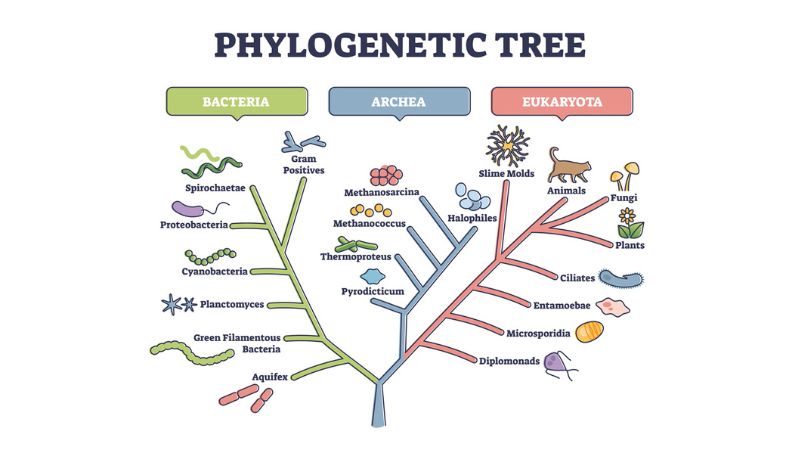
Animalia’s Place
According to the diagram, kingdoms are smaller hierarchies within domains, and the Animalia Kingdom belongs to the Domain Eukarya, which includes organisms with nuclei. In terms of species richness, Animalia occupies the top position among them.
The Six Kingdoms Of Animals Overview
The classification of living organisms into kingdoms has evolved significantly, resulting in five- and six-kingdom models. Robert Whittaker’s five-kingdom system, introduced in 1969, remains foundational but has been refined to include a six-kingdom approach separating prokaryotic life into distinct groups.
The Six Kingdoms of Life:
- Kingdom Animalia: Multicellular, eukaryotic, and heterotrophic organisms. They exhibit mobility and complex nervous systems, including mammals, birds, reptiles, and invertebrates.
- Kingdom Plantae: Multicellular, eukaryotic autotrophs capable of photosynthesis. Examples include flowering plants, mosses, and ferns, characterized by cellulose-based cell walls.
- Kingdom Fungi: Predominantly multicellular eukaryotes (e.g., mushrooms, molds) that absorb nutrients from their surroundings. They are essential for decomposition and nutrient cycling.
- Kingdom Protista: A diverse group of mostly unicellular eukaryotes such as algae and protozoa, which do not fit into other kingdoms.
- Kingdom Bacteria: Comprising Eubacteria, true bacteria distinguished by their cell wall structure and varied metabolic pathways.
- Kingdom Archaea: Ancient prokaryotes thriving in extreme environments, with unique genetic and biochemical traits that set them apart from bacteria.
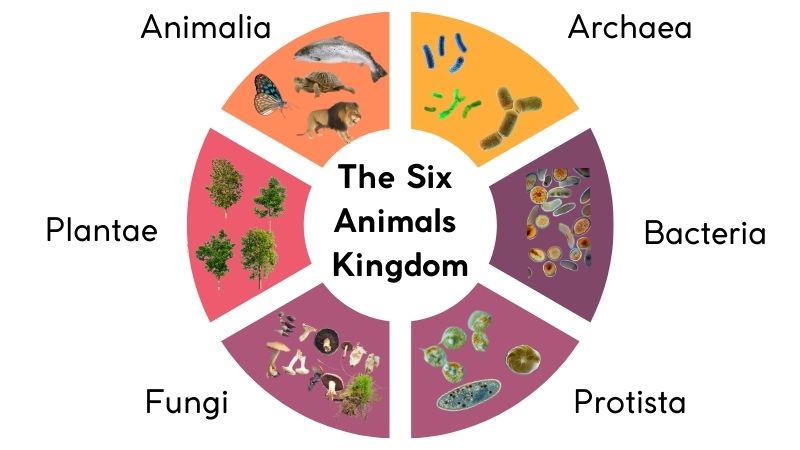
While the first four kingdoms—Animalia, Plantae, Fungi, and Protista—remain unchanged from Whittaker’s model, the addition of Archaea and Bacteria highlights the growing recognition of molecular and structural differences within prokaryotic life. This expanded classification enhances our understanding of life’s diversity and evolutionary history.
Deep Dive Into Seven Phylas of Kingdom Animalia
The animal kingdom is divided into various phyla, each representing distinct groups of organisms with shared characteristics. Below are seven notable phyla:
- Porifera: Simple, multicellular organisms like sponges that lack true tissues and organs. They inhabit aquatic environments and filter feed by drawing water through their porous bodies.
- Cnidaria: Includes jellyfish, corals, and sea anemones. Cnidarians feature radial symmetry and specialized stinging cells, cnidocytes, for capturing prey.
- Platyhelminthes: Known as flatworms, such as planarians and tapeworms. These organisms have flattened bodies, lack coelom, and include both free-living and parasitic species.
- Nematoda: Roundworms with unsegmented, cylindrical bodies. Found in diverse habitats, they play roles as decomposers or parasites, contributing to ecosystem dynamics.
- Annelida: Segmented worms like earthworms and leeches. Their segmented body structure enhances flexibility and mobility.
- Arthropoda: The largest animal phylum, encompassing insects, spiders, and crustaceans. Arthropods have jointed appendages, segmented bodies, and a chitinous exoskeleton.
- Chordata – Vertebrates: Includes all animals with a notochord at some life stage, such as vertebrates like mammals, birds, and fish. Chordates typically possess a backbone and exhibit complex organ systems.
These phyla demonstrate the animal kingdom’s immense diversity and evolutionary complexity, showcasing adaptations that allow species to thrive in varied environments.
Six Classes of Animals within Kingdom Animalia
The Kingdom Animalia is divided into various classes within its phyla, but broadly, the six major classes often referred to are categorized based on specific traits. These are:
- Mammal: Animals belonging to the class Mammalia are referred to as mammals. There are many different species of mammals in the animal kingdom, but mammals are among the most evolved. They have mammary glands that help them make milk to feed their young and are warm-blooded animals. Lungs are the organs responsible for respiration. Squirrels, lions, and kangaroos are some examples of mammals.
- Birds: The class Aves includes all birds. These animals lay eggs and are warm-blooded. Birds’ forelimbs are modified into wings, while their hindlimbs allow them to walk, hop, perch, grasp, wade, and swim. Courtship, parental care, nest building, and territorial behavior are all visible in their behavior. The extinct archaeopteryx, the penguin, and duck are members of the Aves class.
- Reptiles: They are among the first organisms to move from the water to the land. They evolved billions of years ago from amphibians. The animal is a cold-blooded species found in most warm regions of the world whose skin is dry, rough, and glandless. Reptiles include snakes, turtles, and crocodiles, which are common representatives.
- Amphibians: These are multicellular vertebrates that live both on land and water. There are no scales on the skin, but there are glands that make it moist. Fertilization usually occurs externally and they respire through their skin and lungs. A few of the most famous Amphibians are the frog, salamander, and toad.
- Fish: Pisces class encompasses all fish. They are jawed vertebrates with specific respiratory, excretory, and blood circulation organs. The organisms in this group are called poikilotherms, which means they cannot regulate their body temperatures. Salmon, sharks, and mackerel are all in the Pisces class.
- Insects: Insects are multicellular invertebrates with a segmented body divided into the head, thorax, and abdomen. They have an exoskeleton, three pairs of legs, and often wings. Insects breathe through spiracles and reproduce sexually, with most laying eggs. Examples include ants, butterflies, and beetles.
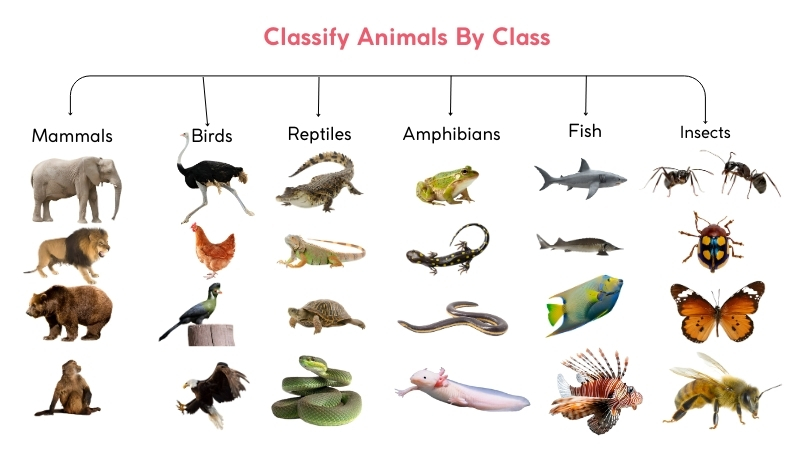
Animal Families and Order
Animal families and orders represent crucial levels in the biological classification system, helping scientists organize and understand the vast diversity of animal life. Orders group animals based on shared characteristics and evolutionary traits, while families provide a narrower classification within each order, encompassing species with even closer relationships. Together, these levels illustrate how animals are related and adapted to their environments.
For instance, reptiles demonstrate the utility of this classification system through their four main orders:
Reptiles
├── Order Crocodilia
│ ├── Family Crocodylidae (Crocodiles)
│ ├── Family Alligatoridae (Alligators and Caimans)
│ └── Family Gavialidae (Gharials)
├── Order Sphenodontia
│ └── Family Sphenodontidae (Tuatara)
├── Order Squamata
│ ├── Family Iguanidae (Iguanas)
│ ├── Family Colubridae (Colubrid Snakes)
│ ├── Family Viperidae (Vipers and Pit Vipers)
│ └── Family Scincidae (Skinks)
└── Order Testudines
├── Family Testudinidae (Tortoises)
├── Family Emydidae (Pond Turtles and Box Turtles)
├── Family Cheloniidae (Sea Turtles)
└── Family Trionychidae (Softshell Turtles)
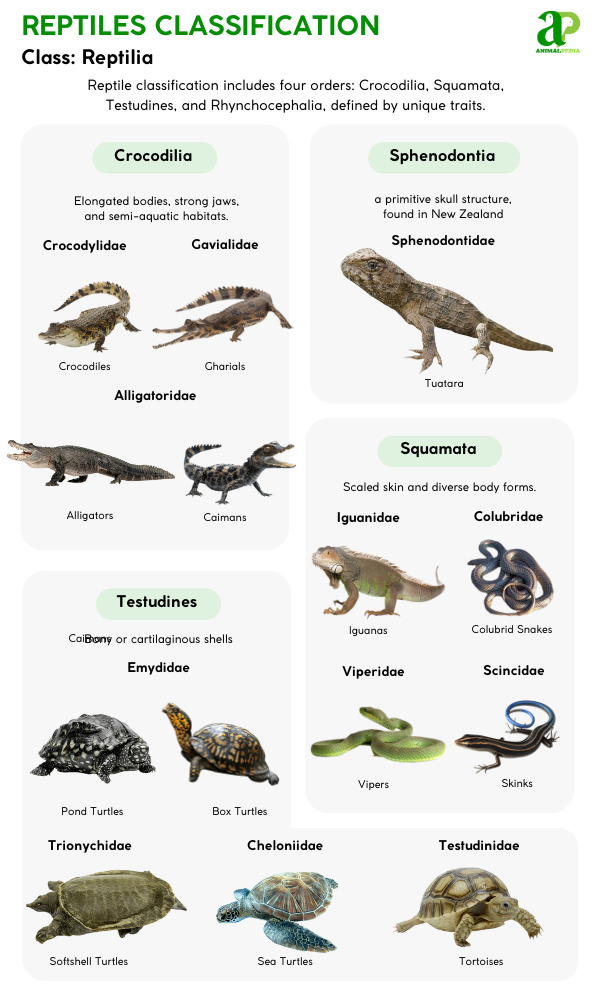
Animal Genus and Species
Animal genus and species represent the most specific levels of biological classification, identifying individual organisms and their closest relatives. Genus groups are closely related species, while species refers to a single, distinct organism capable of interbreeding within its group. These levels provide detailed insights into an animal’s evolutionary relationships, behaviors, and ecological roles.
For example, within the order Squamata, which includes lizards and snakes, we observe the diversity of genera and species:
Squamata
├── Genus Iguana
│ └── Species: Iguana iguana (Green Iguana)
├── Genus Varanus
│ ├── Species: Varanus komodoensis (Komodo Dragon)
│ └── Species: Varanus salvator (Water Monitor)
├── Genus Crotalus
│ ├── Species: Crotalus atrox (Western Diamondback Rattlesnake)
│ └── Species: Crotalus viridis (Prairie Rattlesnake)
├── Genus Chamaeleo
│ └── Species: Chamaeleo calyptratus (Veiled Chameleon)
├── Genus Lampropeltis
│ ├── Species: Lampropeltis getula (Common Kingsnake)
│ └── Species: Lampropeltis triangulum (Milk Snake)
├── Genus Agama
│ └── Species: Agama agama (Common Agama)
└── Genus Anolis
├── Species: Anolis carolinensis (Green Anole)
└── Species: Anolis sagrei (Brown Anole)
FAQs
What are the different types of animals in the animal kingdom?
There are five main classes of vertebrates (animals with backbones): mammals, birds, fish, reptiles, amphibians. Animals without backbones are also common. Invertebrates are these creatures. Arachnids (spiders) and insects are two of the most commonly known classes.
How does the scientific classification system organize animal life?
Today’s classification system is based on the Linnaean system and has eight levels of taxa – domain, kingdom, phylum, class, order, family, genus, and species – from the most general to the most specific.
What are the main classes within the animal kingdom?
The Animal Kingdom is mainly divided into Mammals, Reptiles, Amphibians, Birds, Fish, and Insects.
How has DNA analysis impacted the classification of animals?
Scientists have been able to determine animal and plant genetic relatedness through DNA sequencing. In addition to physical traits, genes can also be used to determine how similar or dissimilar organisms are.
What are the key characteristics that define each phylum in the animal kingdom?
The animal kingdom is incredibly diverse, with each phylum defined by unique characteristics that distinguish it from others. Here’s a breakdown of these defining traits:
- Porifera: Non-motile, porous body, marine habitat.
- Coelenterata (Cnidaria): hollow body, live in colonies as well as solitary.
- Platyhelminthes: dorsoventrally flattened body, have bilateral symmetry, either free-living or parasitic.
- Nematoda: cylindrical body, bilaterally symmetrical and triploblastic, parasitic.
- Annelida: segmented cylindrical body, bilaterally symmetrical and triploblastic, the body is differentiated into head and tail.
- Arthropoda: jointed appendages, exoskeleton and a segmented body, bilaterally symmetrical, open circulatory system.
- Mollusca: less segmented body, bilaterally symmetrical and triploblastic, open circulatory system.
- Echinodermata: radial symmetry and triploblastic, hard calcium carbonate skeleton structure, free-living marine animals.
- Hemichordata: body is soft, fragile, and divided into a proboscis, open circulatory system, separate sexes and external fertilization.
- Chordata: bilaterally symmetrical, triploblastic, possess a notochord and a nerve cord, circulatory system is closed type.
To conclude, the animal kingdom is systematically divided into six main classes: Mammalia, Aves, Reptilia, Amphibia, Pisces, and Insecta. Each class represents unique traits and evolutionary paths, providing a framework to understand how diverse species interact and adapt to their environments. Within these classes, animals are further categorized into orders, families, genera, and species, enabling us to explore their fascinating relationships and characteristics in detail.
We hope this article has illuminated the intricate structure of animal classification, making it easier to grasp the natural world’s complexity. Continue exploring Animal Pedia to delve deeper into each class and discover the incredible diversity that makes our planet extraordinary. Your curiosity is the key to unlocking the wonders of the animal kingdom!

